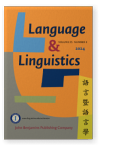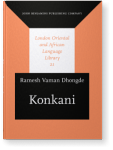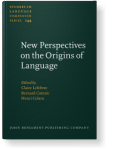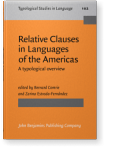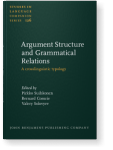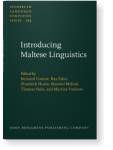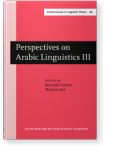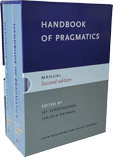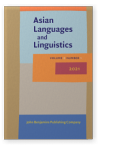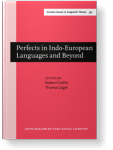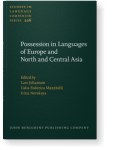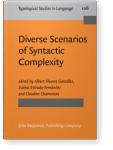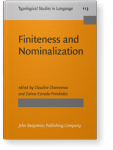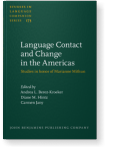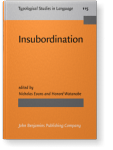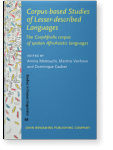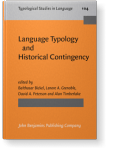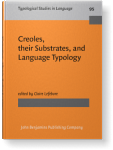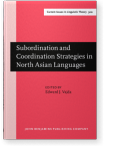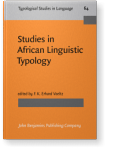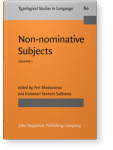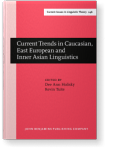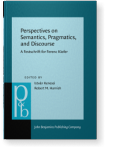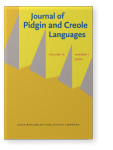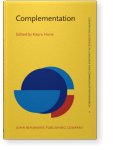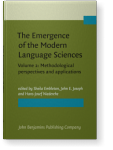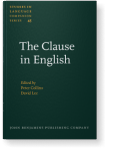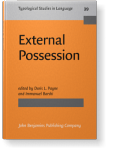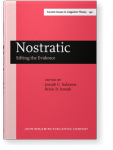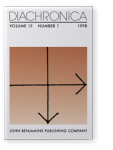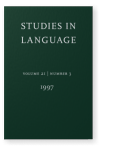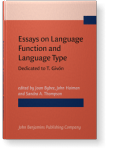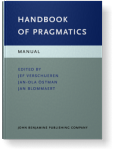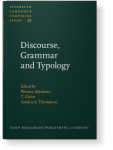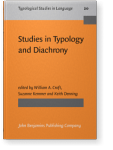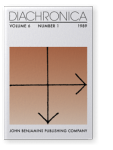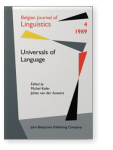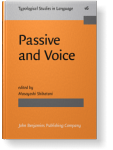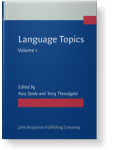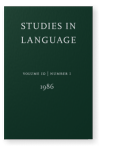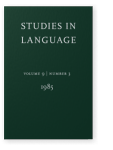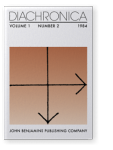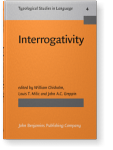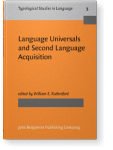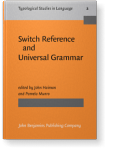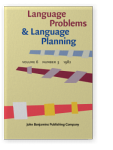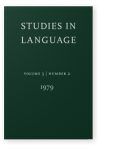Bernard Comrie
List of John Benjamins publications for which Bernard Comrie plays a role.
Journals
Book series
Noun-Modifying Clause Constructions in Languages of Eurasia: Rethinking theoretical and geographical boundaries
Edited by Yoshiko Matsumoto, Bernard Comrie and Peter Sells
[Typological Studies in Language, 116] 2017. vi, 381 pp.
Subjects Semantics | Syntax | Theoretical linguistics | Typology
New Perspectives on the Origins of Language
Edited by Claire Lefebvre, Bernard Comrie and Henri Cohen
[Studies in Language Companion Series, 144] 2013. xvi, 582 pp.
Subjects Evolution of language | Historical linguistics | Theoretical linguistics
Relative Clauses in Languages of the Americas: A typological overview
Edited by Bernard Comrie and Zarina Estrada-Fernández
[Typological Studies in Language, 102] 2012. xiii, 307 pp.
Subjects Historical linguistics | Languages of North America | Languages of South America | Syntax | Typology
Argument Structure and Grammatical Relations: A crosslinguistic typology
Edited by Pirkko Suihkonen, Bernard Comrie and Valery Solovyev
[Studies in Language Companion Series, 126] 2012. xv, 406 pp.
Subjects Semantics | Syntax | Theoretical linguistics | Typology
Introducing Maltese Linguistics: Selected papers from the 1st International Conference on Maltese Linguistics, Bremen, 18–20 October, 2007
Edited by Bernard Comrie, Ray Fabri, Elizabeth Hume, Manwel Mifsud, Thomas Stolz and Martine Vanhove
[Studies in Language Companion Series, 113] 2009. xi, 422 pp.
Subjects Afro-Asiatic languages | English linguistics | Theoretical linguistics
Linguistic Borrowing in Bilingual Contexts
Fredric Field
[Studies in Language Companion Series, 62] 2002. xviii, 252 pp.
Subjects Multilingualism | Sociolinguistics and Dialectology
Causatives and Transitivity
Edited by Bernard Comrie and Maria Polinsky
[Studies in Language Companion Series, 23] 1993. x, 399 pp.
Subjects Functional linguistics | Theoretical linguistics | Typology
Perspectives on Arabic Linguistics: Papers from the Annual Symposium on Arabic Linguistics. Volume III: Salt Lake City, Utah 1989
Edited by Bernard Comrie and Mushira Eid
[Current Issues in Linguistic Theory, 80] 1991. xii, 274 pp.
Subjects Afro-Asiatic languages
Typology of Resultative Constructions: Translated from the original Russian edition (1983)
Edited by Vladimir P. Nedjalkov
[Typological Studies in Language, 12] 1988. xx, 573 pp.
Subjects Syntax | Theoretical linguistics | Typology
2022 Typology Handbook of Pragmatics: Manual, Verschueren, Jef and Jan-Ola Östman (eds.), pp. 1461–1464 | Chapter
2021 Chapter 6. Swedish FrameNet++ and comparative linguistics The Swedish FrameNet++: Harmonization, integration, method development and practical language technology applications, Dannélls, Dana, Lars Borin and Karin Friberg Heppin (eds.), pp. 139–166 | Chapter
In this chapter we describe a multilingual extension of Swedish FrameNet++, intended to address research questions of a broad comparative nature, in genealogical, areal and typological linguistics, focusing on the integration into Swedish FrameNet++ of so-called core vocabularies, used in several… read more
2021 Expanding the boundaries of Asian linguistics: Great Andamanese languages Asian Languages and Linguistics 2:1, pp. 1–23 | Article
While the general lines of the areal linguistic typology of Asia are well known, there are some less well understood pockets that promise to throw light on the overall range of variation within the continent. These include the indigenous languages of the Andaman Islands, which have for much of… read more
2021 Chapter 16. Antipassives in Nakh-Daghestanian languages: Exploring the margins of a construction Antipassive: Typology, diachrony, and related constructions, Janic, Katarzyna and Alena Witzlack-Makarevich (eds.), pp. 515–548 | Chapter
Several Nakh-Daghestanian languages present constructions that are candidate antipassives, in that the construction is intransitive and is (at least sometimes) related to a corresponding transitive construction, with A of the transitive construction appearing as S of the intransitive, and P of… read more
2020 Chapter 1. Introduction Perfects in Indo-European Languages and Beyond, Crellin, Robert and Thomas Jügel (eds.), pp. 1–14 | Chapter
This Introduction highlights some of the recurrent themes of the volume, in particular two diachronic paths: (i) resultative > perfect > perfective past; (ii) relaxation of an initial constraint restricting the perfect to results attributed to the patient. The latter leads to a discussion of be… read more
2019 Possessive chains and Possessor Camouflage Possession in Languages of Europe and North and Central Asia, Johanson, Lars, Lidia Federica Mazzitelli and Irina Nevskaya (eds.), pp. 51–84 | Chapter
In most recursive possessive chains like English the color of the covers of thebooks and the girl’s father’s house, from knowing the morphosyntax of possessor and possessum in bipartite constructions (the color of the books, the girl’s house), one can predict the morphosyntax of the intermediate… read more
2019 Switch-reference in Kobon and Haruai: Areal influences within Highland New Guinea Diverse Scenarios of Syntactic Complexity, Álvarez González, Albert, Zarina Estrada-Fernández and Claudine Chamoreau (eds.), pp. 13–26 | Chapter
Kobon and Haruai are two neighboring unrelated Papuan languages with similar syntactic typology. Within the overall space of cross-linguistic variation, their switch-reference systems are remarkably similar, though not identical, for instance strictly tracking the referent of the grammatical… read more
2018 Chapter 3. Affective constructions in Tsezic languages Non-Canonically Case-Marked Subjects: The Reykjavík-Eyjafjallajökull papers, Barðdal, Jóhanna, Na'ama Pat-El and Stephen Mark Carey (eds.), pp. 55–82 | Chapter
This article addresses affective (“experiencer”) constructions in the Tsezic languages (Nakh-Daghestanian), which represent the most frequent type of non-canonical subject constructions in these languages. They differ from transitive constructions in a number of ways that go far beyond case marking… read more
2017 General noun-modifying clause constructions in Hinuq and Bezhta, with a note on other Daghestanian languages Noun-Modifying Clause Constructions in Languages of Eurasia: Rethinking theoretical and geographical boundaries, Matsumoto, Yoshiko, Bernard Comrie and Peter Sells (eds.), pp. 121–146 | Article
Hinuq and Bezhta, two languages of the Tsezic sub-group of the Nakh-Daghestanian (East Caucasian) language family, have General noun modifying clause constructions (GNMCCs), which have also been noted in some other Nakh-Daghestanian languages. While readily acceptable and interpretable, GNMCCs that… read more
2017 Conclusion Noun-Modifying Clause Constructions in Languages of Eurasia: Rethinking theoretical and geographical boundaries, Matsumoto, Yoshiko, Bernard Comrie and Peter Sells (eds.), pp. 331–337 | Article
In this conclusion, we address three issues: a) the geographic extent of GNMCCs in Eurasia, including considerations of areal phenomena resulting from language contact; b) delimiting GNMCCs from other constructions, in particular those that in Japanese fall under GNMCCs; and c) structural… read more
2017 Noun-modifying clause constructions in languages of Eurasia: Rethinking theoretical and geographical boundaries Noun-Modifying Clause Constructions in Languages of Eurasia: Rethinking theoretical and geographical boundaries, Matsumoto, Yoshiko, Bernard Comrie and Peter Sells (eds.), pp. 3–21 | Article
2016 Finiteness in Haruai Finiteness and Nominalization, Chamoreau, Claudine and Zarina Estrada-Fernández (eds.), pp. 71–82 | Article
Haruai, a non-Austronesian (“Papuan”) language of Papua New Guinea distinguishes, in terms of the indexing of person-number in the verb, between finite, semi-finite, and non-finite verb forms. There is a high, though not absolute, correlation between this scale and the scale running from main… read more
2016 Measuring language typicality, with special reference to the Americas Language Contact and Change in the Americas: Studies in honor of Marianne Mithun, Berez-Kroeker, Andrea L., Diane M. Hintz and Carmen Jany (eds.), pp. 363–384 | Article
The World Atlas of Language Structures provides a means of calculating the index of typicality of a language, as the average of the percentage of the world’s languages that share that language’s feature value for each feature. Concentrating on languages represented by at least 100 features gives a… read more
2016 Chapter 7. Insubordination in the Tsezic Languages Insubordination, Evans, Nicholas and Honoré Watanabe (eds.), pp. 171–182 | Article
The Tsezic languages present a number of prima facie instances of insubordination, given current definitions of this phenomenon. For the purposes of this chapter, we base ourselves on the definition provided by Evans (2007: 367): “[Insubordination is] the conventionalized main clause use of what,… read more
2015 From the Leipzig Glossing Rules to the GE and RX lines Corpus-based Studies of Lesser-described Languages: The CorpAfroAs corpus of spoken AfroAsiatic languages, Mettouchi, Amina, Martine Vanhove and Dominique Caubet (eds.), pp. 207–219 | Article
The Leipzig Glossing Rules (http://www.eva.mpg.de/lingua/resources/glossing-rules.php) were devised with a very specific purpose in mind, namely to standardize the notations used by linguists in order to present the morphological structure of example sentences in language structures unfamiliar to… read more
2013 Ergativity: Some recurrent themes The Acquisition of Ergativity, Bavin, Edith L. and Sabine Stoll (eds.), pp. 15–34 | Article
The article examines four areas within ergativity that merit further consideration, including with respect to child language acquisition data: (1) syntactic alignment, including in particular the delimitation of semantic alignment from other kinds of alignment with lexical exceptions, and symmetric… read more
2013 Some observations on typological features of hunter-gatherer languages Language Typology and Historical Contingency: In honor of Johanna Nichols, Bickel, Balthasar, Lenore A. Grenoble, David A. Peterson and Alan Timberlake (eds.), pp. 383–394 | Article
The introduction of agriculture is a major event in human history, and this article offers a preliminary investigation into whether there might be structural features of language correlating with the distinction between languages spoken by hunter-gatherers and agriculturalists. A number of feature… read more
2012 Introduction Argument Structure and Grammatical Relations: A crosslinguistic typology, Suihkonen, Pirkko, Bernard Comrie and Valery Solovyev (eds.), pp. xiii–xvi | Article
2012 Some argument-structure properties of ‘give’ in the languages of Europe and Northern and Central Asia Argument Structure and Grammatical Relations: A crosslinguistic typology, Suihkonen, Pirkko, Bernard Comrie and Valery Solovyev (eds.), pp. 17–36 | Article
The alignment typology of ditransitive constructions with the verb ‘give’ in languages of Europe and Northern and Central Asia is overwhelmingly of the indirective type, although there are sporadic occurrences of double object and secundative alignment, usually as alternatives to indirective… read more
2012 Introduction Relative Clauses in Languages of the Americas: A typological overview, Comrie, Bernard and Zarina Estrada-Fernández (eds.), pp. ix–xiv | Article
2012 The evolution of language and elaborateness of grammar: The case of relative clauses in creole languages Relative Clauses in Languages of the Americas: A typological overview, Comrie, Bernard and Zarina Estrada-Fernández (eds.), pp. 27–46 | Article
Starting from the assumption that creole languages present an opportunity for testing hypotheses on the evolution of complexity in language, we examine the number of markers used to construct relative clauses, more specifically in relativization on subjects. On the basis of a sample of 52 creole… read more
2011 Creoles and language typology Creoles, their Substrates, and Language Typology, Lefebvre, Claire (ed.), pp. 599–611 | Article
The distinct social origin of creoles, along with pidgins and mixed languages, makes them a source of interest to typologists, given their interest in the cross-linguistic distribution of structural feature values. Typologists, like creolists before them, are interested in issues such as whether… read more
2010 Typology Variation and Change: Pragmatic perspectives, Fried, Mirjam, Jan-Ola Östman and Jef Verschueren (eds.), pp. 234–238 | Article
2009 Maltese and the World Atlas of Language Structures Introducing Maltese Linguistics: Selected papers from the 1st International Conference on Maltese Linguistics, Bremen, 18–20 October, 2007, Comrie, Bernard, Ray Fabri, Elizabeth Hume, Manwel Mifsud, Thomas Stolz and Martine Vanhove (eds.), pp. 3–11 | Article
2008 Inflectional morphology and language contact, with special reference to mixed languages Language Contact and Contact Languages, Siemund, Peter and Noemi Kintana (eds.), pp. 15–32 | Article
2008 Subordination, coordination: Form, semantics, pragmatics Subordination and Coordination Strategies in North Asian Languages, Vajda, Edward J. (ed.), pp. 1–16 | Miscellaneous
2006 The typology of relative clause formation in African languages Studies in African Linguistic Typology, Voeltz, F.K. Erhard (ed.), pp. 209–228 | Article
2004 5. Oblique-case subjects in Tsez Non-nominative Subjects: Volume 1, Bhaskararao, Peri and Karumuri V. Subbarao (eds.), pp. 113 ff. | Chapter
2003 Left, right, and the cardinal directions: Some thoughts on consistency and usage Motion, Direction and Location in Languages: In honor of Zygmunt Frajzyngier, Shay, Erin and Uwe Seibert (eds.), pp. 51–58 | Article
2003 Constraints on Reflexivization in Tsez Current Trends in Caucasian, East European and Inner Asian Linguistics: Papers in honor of Howard I. Aronson, Holisky, Dee Ann and Kevin Tuite (eds.), pp. 265–289 | Article
2002 Participles in Tsez: An emergent word class? Complex Sentences in Grammar and Discourse: Essays in honor of Sandra A. Thompson, Bybee, Joan L. and Michael Noonan (eds.), pp. 19–30 | Article
2002 6. Morphophonological alternations: Typology and diachrony Morphology 2000: Selected papers from the 9th Morphology Meeting, Vienna, 24–28 February 2000, Bendjaballah, Sabrina, Wolfgang U. Dressler, Oskar E. Pfeiffer and Maria D. Voeikova (eds.), pp. 73–89 | Chapter
2001 “Love your enemies”: Affective constructions in two Daghestanian languages Perspectives on Semantics, Pragmatics, and Discourse: A Festschrift for Ferenc Kiefer, Kenesei, István and Robert M. Harnish (eds.), pp. 59–72 | Article
2000 Review of Adone & Plag (1994): Creolization and language change Journal of Pidgin and Creole Languages 15:1, pp. 221–225 | Review
2000 Introduction Complementation: Cognitive and functional perspectives, Horie, Kaoru (ed.), pp. 1–10 | Chapter
1999 40. Gender Affixes in Tsez: Synchrony and diachrony The Emergence of the Modern Language Sciences: Studies on the transition from historical-comparative to structural linguistics in honour of E.F.K. Koerner, Embleton, Sheila, John E. Joseph and Hans-Josef Niederehe (eds.), pp. 279 ff. | Article
1999 Relative clauses: Structure and typology on the periphery of standard English The Clause in English: In honour of Rodney Huddleston, Collins, Peter and David Lee (eds.), pp. 81 ff. | Article
1999 Form and Function in Syntax: Relative clauses in Tsez Functionalism and Formalism in Linguistics: Volume II: Case studies, Darnell, Michael, Edith A. Moravcsik, Michael Noonan, Frederick J. Newmeyer and Kathleen Wheatley (eds.), pp. 77 ff. | Article
1999 Possessor Raising in a Language that Does Not Have Any External Possession, Payne, Doris L. and Immanuel Barshi (eds.), pp. 523 ff. | Article
1998 Regular Sound Correspondences and Long-Distance Genetic Comparison Nostratic: Sifting the Evidence, Salmons, Joseph C. and Brian D. Joseph (eds.), pp. 271 ff. | Article
1998 The great Daghestan case coax Case, Typology and Grammar: In honor of Barry J. Blake, Siewierska, Anna and Jae Jung Song (eds.), pp. 95 ff. | Article
1998 Review of Jucker (1995): Historical Pragmatics: Pragmatic Developments in the History of English Diachronica 15:1, pp. 165–174 | Review
1997 Review of Pagliuca (1994): Perspectives on Grammaticalization Diachronica 14:1, pp. 163–166 | Review
1997 Markedness Handbook of Pragmatics: 1996 Installment, Verschueren, Jef, Jan-Ola Östman, Jan Blommaert † and Chris Bulcaen (eds.), pp. 1–13 | Article
1997 Wehr, Barbara. SE-Diathese im Italienischen Studies in Language 21:3, pp. 712–714 | Squib
1997 The Typology of Predicate Case Marking Essays on Language Function and Language Type: Dedicated to T. Givón, Bybee, Joan L., John Haiman and Sandra A. Thompson (eds.), pp. 39 ff. | Article
1996 Some thoughts on being minimal Theoretical Linguistics and Grammatical Description: Papers in honour of Hans-Heinrich Lieb, Sackmann, Robin and Monika Budde (eds.), pp. 77–87 | Article
1995 Jazyki mira: Ural'skie jazyki Studies in Language 19:2, pp. 573–575 | Squib
1995 Typology Handbook of Pragmatics: Manual, Verschueren, Jef, Jan-Ola Östman and Jan Blommaert † (eds.), pp. 551–553 | Article
1995 Complement Clauses versus Relative Clauses: Some Khmer Evidence Discourse, Grammar and Typology: Papers in honor of John W.M. Verhaar, Abraham, Werner, T. Givón and Sandra A. Thompson (eds.), pp. 65 ff. | Article
1993 Some remarks on causatives and transitivity in Haruai Causatives and Transitivity, Comrie, Bernard and Maria Polinsky (eds.), pp. 315 ff. | Article
1991 On the Importance of Arabic to General Linguistic Theory Perspectives on Arabic Linguistics: Papers from the Annual Symposium on Arabic Linguistics, Comrie, Bernard and Mushira Eid (eds.), pp. 3 ff. | Article
1991 How much pragmatics and how much grammar: yhe case of Haruai Pragmatics at Issue: Selected papers of the International Pragmatics Conference, Antwerp, August 17–22, 1987, Verschueren, Jef (ed.), pp. 81–92 | Article
1990 Review of Lehmann (1990): Language Typology 1987: Systematic Balance in Language Diachronica 7:2, pp. 273–276 | Review
1990 Prolegomena to a typology of Tough Movement Studies in Typology and Diachrony: Papers presented to Joseph H. Greenberg on his 75th birthday, Croft, William A., Suzanne Kemmer and Keith Denning (eds.), pp. 43 ff. | Article
1989 Chapter 18. Word order in the Germanic Languages — Subject-verb or verb second?: Evidence
from
aphasia in Scandinavian languages Agrammatic Aphasia: A cross-language narrative sourcebook, Menn, Lise and Loraine K. Obler (eds.), pp. 1357–1364 | Chapter
1989 Review of Décsy (1988): A Select Catalog of Language Universals Diachronica 6:1, pp. 137–139 | Review
1989 Translatability and Language Universals Universals of Language, Kefer, Michel and Johan van der Auwera (eds.), pp. 53–67 | Article
1988 Foreword Typology of Resultative Constructions: Translated from the original Russian edition (1983), Nedjalkov, Vladimir P. (ed.), pp. ix ff. | Miscellaneous
1988 Passive and voice Passive and Voice, Shibatani, Masayoshi (ed.), pp. 9 ff. | Article
1987 Grammatical relations, semantic roles and topic-comment structure in a New Guinea Highland language: Harway Language Topics: Essays in honour of Michael Halliday, Steele, Ross and Terry Threadgold (eds.), pp. 355 ff. | Article
1987 Grammatical relations, semantic roles and topic-comment structure in a New Guinea Highland language: Harway Language Topics: Essays in honour of Michael Halliday, Steele, Ross and Terry Threadgold (eds.), pp. 355 ff. | Article
1986 Review of Abraham (1983): On the Formal Syntax of the Westgermania Studies in Language 10:1, pp. 241–247 | Review
1984 Review of Andersen (1983): Word Order Typology and Comparative Constructions Diachronica 1:2, pp. 255–260 | Review
1984 Russian Interrogativity: A colloquium on the grammar, typology and pragmatics of questions in seven diverse languages, Cleveland, Ohio, October 5th 1981-May 3rd 1982, Chisholm, William, Louis T. Milic and John A.C. Greppin (eds.), pp. 7 ff. | Article
1984 Why linguists need laguage acquirers Language Universals and Second Language Acquisition, Rutherford, William E. (ed.), pp. 11 ff. | Article
1983 Switch-reference in Huichol: A typological study Switch Reference and Universal Grammar: Proceedings of a symposium on switch reference and universal grammar, Winnipeg, May 1981, Haiman, John and Pamela Munro (eds.), pp. 17 ff. | Article
1979 Review of Dik (1978): Functional Grammar Studies in Language 3:2, pp. 267–276 | Review

